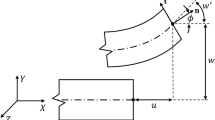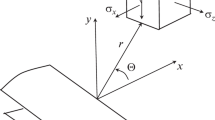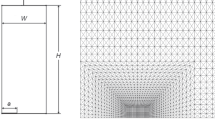Abstract
Three-dimensional finite-element analyses of middle-crack tension (M-T) and bend specimens subjected to mode I loadings were performed to study the stress singularity along the crack front. The specimen was modeled using 20-node isoparametric elements with collapsed, non-singular elements at the crack front. The displacements and stresses from the analysis were used to estimate the power of singularities using a log-log regression analysis along the crack front. The analyses showed that finite-sized cracked bodies have two singular stress fields. The near-field singular stress has the form σ =C 0(θ,z)r -/12' +D 0 (0,ϕ)R λ σ The first term is the cylindrical singularity with the power -1/2 and is dominant over the middle 96 percent (for Poisson's ratio = 0.3) of the crack front and becomes nearly zero at the free surface. The second singularity is a vertex singularity with the vertex point located at the intersection of the crack front and the free surface. The second singularity is dominant at the free surface and becomes nearly zero away from the boundary layer. The thickness of the boundary layer depends on Poisson's ratio of the material and is independent of the specimen type. The thickness of the boundary layer was about 0%, 2%, 4%, and 5% of the total specimen thickness for Poisson's ratio of 0.0, 0.3, 0.4, and 0.45, respectively.
Because there are two singular fields near the free surface, the strain-energy-release rate (G) is an appropriate parameter to measure the severity of the crack front. The G-distribution for M-T and bend specimens were different.
Similar content being viewed by others
Abbreviations
- a :
-
crack length, m
- E :
-
Young's modulus, GPa
- G :
-
strain-energy-release rate, J/m'
- G pε :
-
plane-strain, strain-energy-release rate, J/m2
- H :
-
height of specimen, m
- P :
-
load per unit length, N/mm
- R, O, ϕ :
-
spherical coordinate system
- r, O, z :
-
cylindrical coordinate system
- S :
-
remote tension stress, N/mm2
- t :
-
specimen thickness, m
- t ti :
-
ith layer thickness, m
- u, v, w :
-
displacements inx-, y-, andz-directions, m
- x, y, z :
-
Cartesian coordinates, m
- W :
-
half-width of the specimen, m
- λ σ :
-
power of the stress singularity
- λ ν :
-
power of displacement field
- v :
-
Poisson's ratio
- σ y :
-
normal stress in y-direction, GPa
References
G.C. Sih, M.L. Williams and J.L. Swedlow, Three-Dimensional Stress Distribution Near a Sharp Crack in a Plate of Finite Thickness. AFML-TR-66-242, Air Force Materials Laboratory, Wright-Patterson Air Force Base (1966).
R.J. Hartranft and G.C. Sih,International Journal of Engineering Science 8 (1970) 711–729.
G.C. Sih,International Journal of Fracture Mechanics 7, No. 1 (1971) 39–61.
J.P. Benthem,International Journal of Solids and Structures 13 (1977) 479–492.
J.P. Benthem,International Journal of Solids and Structures 16 (1980) 119–130.
Z.P. Bazant and L.F. Estenssoro,Advances in Research on the Strength and Fracture of Materials, D.M.R. Taplin (ed.) Vol. 3a, Pergamon Press, Oxford (1977) 371–385.
Z.P. Bazant and L.F. Estenssoro,International Journal of Solids and Structures 15 (1979) 405–526.
J.S. Solecki and J.L. Swedlow, inFracture Mechanics Sixteenth Symposium, M.F. Kanninen and A.T. Hopper (eds.), STP 868, American Society for Testing and Materials, Philadelphia (1985) 535–553.
C.W. Smith, J.S. Epstein and O. Olaosebikan, inFracture Mechanics: Seventeenth Volume, STP 905, American Society for Testing and Materials, Philadelphia (1986) 775–788.
C.W. Smith, J.S. Epstein and O. Olaosebikan, inAdvances in Aerospace Structures, Materials and Dynamics, ASME-Aero Div.-06 (1983) 119–126.
C.W. Smith and J.S. Epstein, inProceedings 5th International Congress on Experimental Stress Analysis, June 1984.
K.N. Shivakumar and I.S. Raju,21st National Symposium on Fracture Mechanics, Annapolis, MD, June 28–30, 1988.
K.N. Shivakumar, P.W. Tan and J.C. Newman, Jr.,International Journal of Fracture 36 (1988) R43-R50.
I.S. Raju, K.N. Shivakumar and J.H. Crews, Jr., Three-Dimensional Elastic Analysis of a Composite Double-Cantilver-Beam Specimen. AIAA Paper No. AIAA-87-0864, AIAA/ASME/ASCE/AHS 28th Structures, Structural Dynamics, and Materials Conference, Monterey, CA, April 1987.
I.S. Raju and J.C. Newman, Jr., Three-Dimensional Finite Element Analysis of Finite-Thickness Fracture Specimens, NASA TN D-8414 (1977)
S.N. Atluri, K. Kathiresan and A.S. Kobayashi, Three-Dimensional Linear Elastic Fracture Mechanics Analysis by a Displacement Hybrid Finite Element Model. Paper No. L-7/3, Transactions 3rd Conference on Structural Mechanics in Reactor Technology, London, Sept. 1975.
H.M. Westergaard,Journal of Appl. Mech. 61 (1939) A49–53.
M.L. Williams,Journal of Appl. Mech. 24 (1957) 109–204.
G.R. Irwin,Journal of Appl. Mech. 24 (1957) 361–364.
E. Hinton, F.C. Scott and R.E. Ricketts,International Journal of Numerical Meth. 9 (1975) 235–256.
Author information
Authors and Affiliations
Rights and permissions
About this article
Cite this article
Shivakumar, K.N., Raju, I.S. Treatment of singularities in cracked bodies. Int J Fract 45, 159–178 (1990). https://doi.org/10.1007/BF00693347
Received:
Accepted:
Issue Date:
DOI: https://doi.org/10.1007/BF00693347




